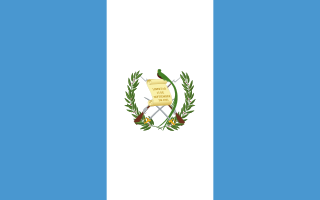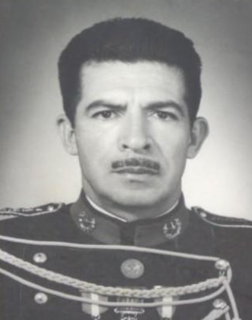
The Maya peoples are a large group of Indigenous peoples of Mesoamerica. They inhabit southern Mexico, Guatemala, Belize, El Salvador and Honduras. The overarching term "Maya" is a collective designation to include the peoples of the region that share some degree of cultural and linguistic heritage; however, the term embraces many distinct populations, societies, and ethnic groups that each have their own particular traditions, cultures, and historical identity.
General Fernando Romeo Lucas García was the 25th President of Guatemala from 1 July 1978 to 23 March 1982. He was democratically elected as Institutional Democratic Party candidate. Elections for his presidency were fraud-ridden. During Lucas García's regime, tensions between the radical left and the government increased. The military started to murder political opponents while counterinsurgency measures further terrorized populations of poor civilians.

The Plan de Sánchez massacre took place in the Guatemalan village of Plan de Sánchez, Baja Verapaz department, on 18 July 1982. Over 250 people were abused and murdered by members of the armed forces and their paramilitary allies.
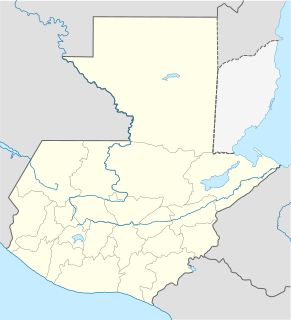
Rabinal is a small town located in the Guatemalan department of Baja Verapaz, at 15°5′4.70″N90°29′20.50″W. It serves as the administrative seat for the surrounding municipality of the same name. The municipality covers 504 km² and, in 2004, had a population of around 36,000. The local people are predominantly Achi Maya Native Americans who speak the Achi Maya language.
In 1994 Guatemala's Commission for Historical Clarification - La Comisión para el Esclarecimiento Histórico (CEH) - was created as a response to the thousands of atrocities and human rights violations committed during the decades long civil war that began in 1962 and ended in the late 1990s with United Nations-facilitated peace accords. The commission operated under a two year mandate, from 1997 to 1999, and employed three commissioners: one Guatemalan man, one male non-national, and one Mayan woman. The mandate of the commission was not to judge but to clarify the past with "objectivity, equity and impartiality."
The Guatemalan Forensic Anthropology Foundation is an autonomous, non-profit, technical and scientific non-governmental organisation. Its aim is to strengthen the administration of justice and respect for human rights by investigating, documenting, and raising awareness about past instances of human rights violations, particularly unresolved murders, that occurred during Guatemala's 30-year-long Civil War.

El Estor is a municipality in the Izabal department of Guatemala. The population of El Estor consists largely of k'ekchi' speaking indigenous people.
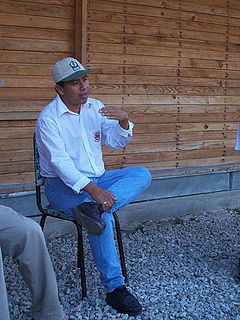
Jesús Tecú Osorio is a Guatemalan social activist, worker for human rights, and advocate for the Achi Maya.

Ixcán is a municipality in the Guatemalan department of El Quiché. Its administrative centre can be found in Playa Grande. The municipality consists of 176 communities, called aldeas. It has an area of 1575 km2. It is the northernmost municipality of El Quiché, and borders with Mexico, the municipalities of Chisec and Cobán of the Department of Alta Verapaz, the municipality of Santa Cruz Barillas of the Department of Huehuetenango, and the municipalities of Chajul and Uspantán of El Quiché.

In 1978, in the face of civil war, the Guatemalan government proceeded with its economic development program, including the construction of the Chixoy hydroelectric dam. Financed in large part by the World Bank and Inter-American Development Bank, the Chixoy Dam was built in Rabinal, a region of the department of Baja Verapaz historically populated by the Maya Achi. To complete construction, the government completed voluntary and forcible relocations of dam-affected communities from the fertile agricultural valleys to the much harsher surrounding highlands. When hundreds of residents refused to relocate, or returned after finding the conditions of resettlement villages were not what the government had promised, these men, women, and children were kidnapped, raped, and massacred by paramilitary and military officials. More than 440 Maya Achi were killed in the village of Río Negro alone, and the string of extrajudicial killings that claimed up to 5,000 lives between 1980 and 1982 became known as the Río Negro massacres. The government officially declared the acts to be counterinsurgency activities - although local church workers, journalists and the survivors of Rio Negro deny that the town ever saw any organized guerrilla activity.
The Salinas is a river in Guatemala. The river is called Río Negro from its sources in the highlands of Huehuetenango and El Quiché until it reaches the Chixoy hydroelectric dam, where the Río Salama and Rio Carchela converge with the Río Negro. After the Chixoy dam, the river is called Río Chixoy and flows northwards through Alta Verapaz until it reaches the border with Mexico. From there on it continues along the border for 113 kilometres (70 mi) as the Salinas river until it finally converges with the Río de la Pasión to form the Usumacinta river which flows into the Gulf of Mexico.
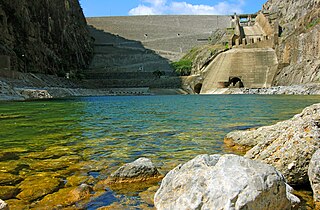
The Chixoy Dam is a reinforced concrete dam and power plant spanning the Chixoy River between the Departments of Baja Verapaz, El Quiché and Alta Verapaz, Guatemala. It is the largest structure of its kind in the country.
The Chixoy River or Río Negro is a river in Guatemala. The river is called Río Negro from its sources in the highlands of Huehuetenango and El Quiché until it reaches the Chixoy hydroelectric dam, where the Río Salamá and Rio Carchela converge with the Río Negro. After the Chixoy dam, the river is called Río Chixoy and flows northwards, marking the departmental limits between Alta Verapaz and El Quiché, until it reaches the border with Mexico. From there on it continues along the border for another 113 kilometres (70 mi) as the Salinas river until it finally converges with the Río la Pasión to form the Usumacinta river which flows into the Gulf of Mexico.

The Guatemalan genocide, Maya(n) genocide, or Silent Holocaust refers to the massacre of Maya civilians during the Guatemalan military government's counterinsurgency operations. Massacres, forced disappearances, torture and summary executions of guerrillas and especially civilian collaborators at the hands of US-backed security forces had been widespread since 1965 and was a longstanding policy of the military regime, which US officials were aware of. A report from 1984 discussed "the murder of thousands by a military government that maintains its authority by terror." Human Rights Watch has described "extraordinarily cruel" actions by the armed forces, mostly against unarmed civilians.
Reparations are broadly understood as compensation given for an abuse or injury. The colloquial meaning of reparations has changed substantively over the last century. In the early 1900s, reparations were interstate exchanges : punitive mechanisms determined by treaty and paid by the surrendering side of conflict, such as the World War I reparations paid by Germany and its allies. Now, reparations are understood as not just war damages but compensation and other measures provided to victims of severe human rights violations by the parties responsible. The right of the victim of an injury to receive reparations and the duty of the part responsible to provide them has been secured by the United Nations.

Franja Transversal del Norte -or Northern Transversal Strip in English- is a region in Guatemala delimited on the north by an imaginary line between Vértice de Santiago in Huehuetenango and Modesto Méndez Port in Izabal and in the south by La Mesilla in Huehuetenango and Izabal lake. It is composed, from west to east, of part of the Guatemalan departments of Huehuetenango, Quiché, Alta Verapaz and the entire department of Izabal. It extends roughly 15750 km2. During the Guatemalan Civil War most of the massacres took place there in that period due to the oil, mineral and precious wood reserves in the region. In the 21st century, there are projects to work in the region and a modern highway was built in 2010.
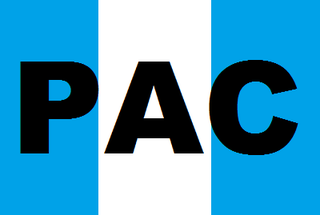
The Civil Defense Patrols were local militias created by the government of Guatemala during the Guatemalan Civil War. They were created by decree of General Ríos Montt on 1 August 1982, though they began before that under President Fernando Romeo Lucas García. Officially, participation was voluntary, but many were forced to join. The patrols officially stopped 29 December 1996 under the terms of the peace treaty that ended the war, though some of the network remained and was used by former members demanding compensation for their involvement. Estimates vary, but statistics generally state that around 1,000,000 people were members of the patrols at the height of the war in 1983. The members tortured and killed other villagers, sometimes at the threat of being killed themselves.
Peru's Truth and Reconciliation Commission (TRC) was a truth and reconciliation commission established by President Alejandro Toledo to investigate the human rights abuses committed during the 1980s and 1990s. The TRC was a response to the violent internal conflict between 1980 and 2000 during the administration of Presidents Fernando Belaúnde (1980-1985), Alan García (1985–1990), and Alberto Fujimori (1990–2000). The commission's mandate was to provide a record of human rights and international humanitarian law violations committed in Peru between May 1980 and November 2000, as well as recommend mechanisms to promote and strengthen human rights. The TRC reported on the estimated 70 000 deaths, assassinations, torture, disappearances, displacement, employment of terrorist methods and other human rights violations executed by the State, Shining Path, and the Túpac Amaru Revolutionary Movement. The report concluded that there is both institutional and individual accountability, as well as identifying racial and cultural factors that became a catalyst for conflict.

